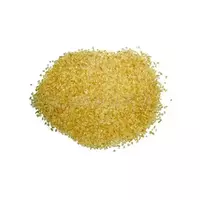Dried garlic

Obviously, the specific taste and smell of garlic is familiar to most people on planet Earth. Garlic acquires such a characteristic taste due to the unique combination of organic sulfide compounds.
The first mention of such a culture as garlic was found in ancient Indian sources. It is believed that it was the highly developed Indo-Iranian people of Aria who became the discoverers of garlic, which allows us to determine the approximate dates when the cultivation of this plant began, about five thousand years ago. Initially, Indians did not use garlic for food.
And garlic heads and feathers were used exclusively in medicine. Moreover, the ancient inhabitants of India have already found out that there are more vitamins and beneficial properties in the feathers of garlic than in the garlic head itself. Much later, scientists found out that garlic leaves contain huge amounts of vitamin C and carotene.
Vitamin C is also present in the garlic head, but in a meager amount, but other groups of vitamins such as V1, V3, PP are added. The ancient Egyptians were the first to add garlic to national cuisine. It was believed that garlic should be consumed daily, then it will strengthen and improve your body.
Ancient artifacts have been preserved - manuscripts of Egyptian doctors, which describe recipes for medicines based on garlic. In cooking, dried garlic seeds are used, as well as feathers of young garlic, which are salted, marinated or stewed.
Dried garlic is added to the seasonings to give a characteristic taste and smell. Koreans and Japanese began to make sauerkraut heads of garlic, now Japanese Black Garlic is known all over the world as a delicacy. Garlic contains a great variety of acids, substances and vitamins useful for the human body.
Most of all, garlic contains polysaccharides and carbohydrates. Notably, when dried garlic is stored, the amount and composition of the beneficial substances may vary. In autumn, after harvesting, garlic contains inulin and sucrose. After the dried garlic lies down for a couple of months, inulin is broken down and the content of sucrose and glucose increases in the composition of garlic.
Dried garlic comes in several species that differ in the form of grinding. There is dried garlic ground into flour (garlic powder), crushed or flaked. Dried garlic is added while preserving vegetables along with other seasonings and spices.
Often dried garlic is used as a taste additive in meat semi-finished products and in sausage products. Dried garlic is widely used in baking. Often, when preparing garlic bread or rolls, garlic flour is added to the dough or the finished product is sprinkled with toasted dried garlic.
dried garlic 345 kCal
Energy value of dried garlic (Ratio of proteins, fats, carbohydrates - ju):
Proteins: 16 g (~ 64 kCal)
Fats: 0.4 g (~ 4 kCal)
Carbohydrates: 75g (~ 300kCal)
Energy ratio (b | y): 19% | 1% | 87%
 Español
Español Français
Français Português
Português Русский
Русский 简体中文
简体中文 繁體中文
繁體中文 日本語
日本語 한국어
한국어 العربية
العربية Türkçe
Türkçe Қазақ
Қазақ Deutsch
Deutsch Italiano
Italiano Українська
Українська
